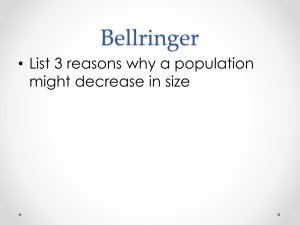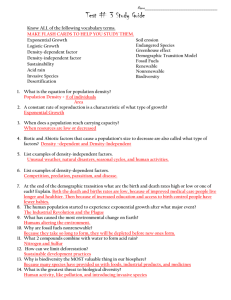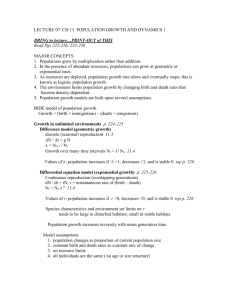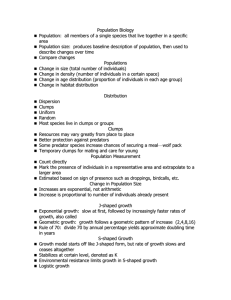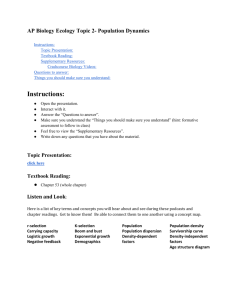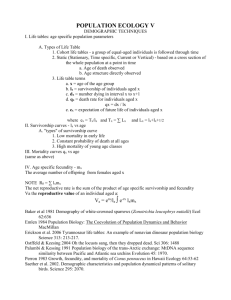Lecture 6
advertisement
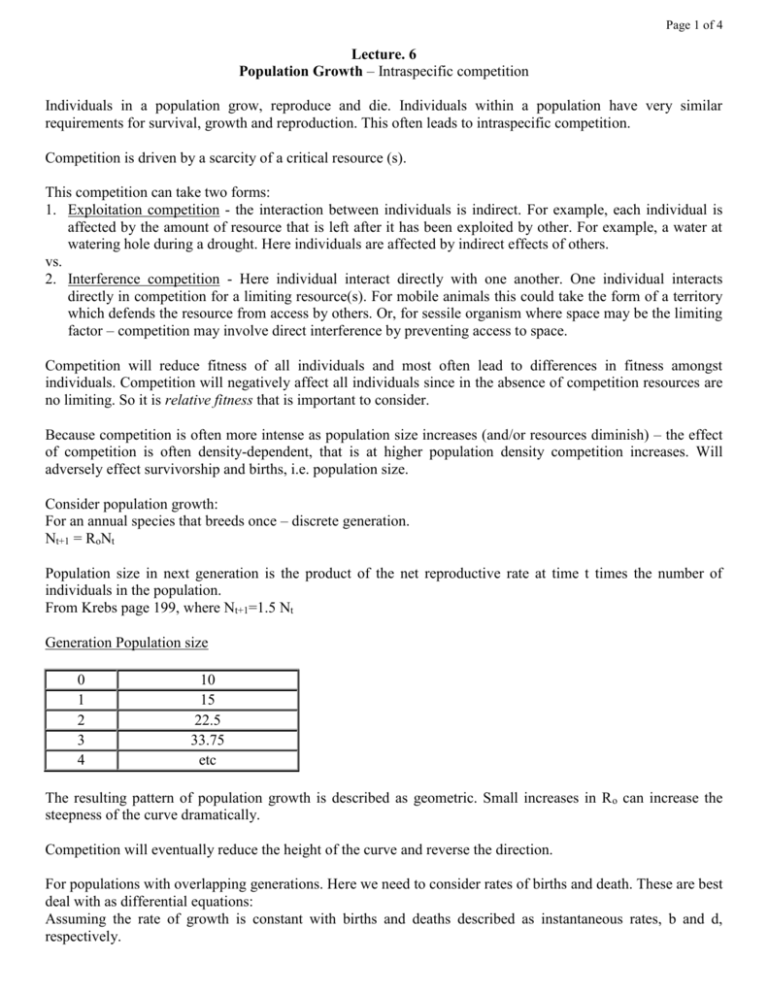
Page 1 of 4 Lecture. 6 Population Growth – Intraspecific competition Individuals in a population grow, reproduce and die. Individuals within a population have very similar requirements for survival, growth and reproduction. This often leads to intraspecific competition. Competition is driven by a scarcity of a critical resource (s). This competition can take two forms: 1. Exploitation competition - the interaction between individuals is indirect. For example, each individual is affected by the amount of resource that is left after it has been exploited by other. For example, a water at watering hole during a drought. Here individuals are affected by indirect effects of others. vs. 2. Interference competition - Here individual interact directly with one another. One individual interacts directly in competition for a limiting resource(s). For mobile animals this could take the form of a territory which defends the resource from access by others. Or, for sessile organism where space may be the limiting factor – competition may involve direct interference by preventing access to space. Competition will reduce fitness of all individuals and most often lead to differences in fitness amongst individuals. Competition will negatively affect all individuals since in the absence of competition resources are no limiting. So it is relative fitness that is important to consider. Because competition is often more intense as population size increases (and/or resources diminish) – the effect of competition is often density-dependent, that is at higher population density competition increases. Will adversely effect survivorship and births, i.e. population size. Consider population growth: For an annual species that breeds once – discrete generation. Nt+1 = RoNt Population size in next generation is the product of the net reproductive rate at time t times the number of individuals in the population. From Krebs page 199, where Nt+1=1.5 Nt Generation Population size 0 1 2 3 4 10 15 22.5 33.75 etc The resulting pattern of population growth is described as geometric. Small increases in R o can increase the steepness of the curve dramatically. Competition will eventually reduce the height of the curve and reverse the direction. For populations with overlapping generations. Here we need to consider rates of births and death. These are best deal with as differential equations: Assuming the rate of growth is constant with births and deaths described as instantaneous rates, b and d, respectively. Page 2 of 4 Then the form of population growth will be: dN/dt = rN=(b-d)N r= b-d, per capita rate of population growth. With b and d instantaneous birth and death rates. Curve will be geometric in form. See Krebs page 204 Can calculate doubling time by setting Nt/No = 2, thus Nt/No=ert 2.0= ert , loge(2.0) = rt, 0.69315/r=t doubling time will be a function of how fast the population is growing, i.e. r in this example r=0.03 then, 0.69315/.03 = 23 years Obviously no population can continue to grow unchecked. If factors begin to operate in a density-dependent way (i.e. effect of competition on birth rate) then we can expect to reach an asymptote after some period of time. Where b=d, the population will become stable, this point is referred to as the carrying capacity, or K. K is defined as the maximum sustained population size, i.e. a reproducing population. The form of the resulting curve is referred to as the logistic growth curve, and is described as by the equation: dN/dt=rN(K-N/K); see Krebs page 207 when N is small there is little effect on population growth, but as N approaches K, r=0 plot of dN/dt over time: see handout The logistic model describes populations whose growth is limited by density-dependent factors. For density dependent control to occur mortality, fecundity or both must be affected by population density. Overhead (see handout) The types of factors that can act in a density-dependent manner are: Predation - affect mortality Parasites - affects fecundity Resources – affect both mortality and fecundity via intra- and inter-specific factors. Forms of competition: exploitative or "scramble" (e.g. ideal-free distribution) interference "contest" (e.g. territoriality) population growth can also be affected by density-independent factors. (handout) Population not at equilibrium, events that cause mortality are independent of density. Factor: weather -> storms, drought (i.e. unpredictable events. Density-dependent and density-independent factors can work together to influence population size. Brief historical background regarding the importance of density vs density-independent factors. Historically, general belief that organisms existed in some natural harmony with environment. The "balance of nature" concept holds that all organisms exist in some delicate equilibrium point. Deviations from this point result of devine intervention or human perturbation. Page 3 of 4 View at the turn of the century among ecologist was that population size were invariant – controlled by densitydependent factors – implicit in Darwin’s thinking. This view was dubbed as the "biotic" school of population control. Supported by Nicholson’s classic blow-fly experiments in the lab. He noted that insects can increase population size 100 times in one generation, therefore they must be controlled by density-dependent factors. He emphasized intra-specific competition in the 1930’s and ‘40’s - it became conventional wisdom over time. General view – mathematical modelers assumed density-dependent at carrying capacity. In contrast, two Australian investigators, Andrewartha and Birch in 1954 proposed that most population were controlled by density-independent processes. Based their thesis from observations made on insects in the field (not lab) where changes in environmental conditions could greatly influence population size, they noted that there was a shortage of time when r was positive, therefore resources (competition) were rarely important. This view became know as know as the "climatic" school of population control. At about the same time, American orithologist, David Lack also came to the conclusion that environmental variation (D.I factors) imposed restrictions on population size more often that did biological (D.D. factors). He asked the explicit question: Are populations of birds controlled by density? If so, reproduction should vary by the number of birds in the population. His studies found that reproductive success was independent of density – rather, the availability of food to support survivorship of offspring was the important factor controlling survivorship. In his system food fluctuates in a density-independent manner which is not competed for by individuals. His seabirds were affected by nutrient conditions in the ocean – during El Ninos which caused low productivity in the water, caused adult birds to abandon their nests. Today, in many systems there remains much debate about the importance in D.D. and D.I., for example within last 15 years much data has accumulated that reef fishes population size is controlled by D.I. processes – not D.D. Idea is that populations are "recruitment limited" by the vagaries of D.I. mortality during their larval life in the open ocean. How can we measure the importance of D.D. vs D.I. factors? One approach is key-factor analysis, developed by Morris in 1957. Refers to the "key" factor controlling population size. see pages 336 -339 in Krebs The method used life table data to look at sources of mortality (could also look at fecundity). Example: Varley 1973 study of Winter Moth. It has discrete stages in the life cycle: adult, egg, larvae, pupae. Followed changes in population size for 12 years. From data year to year changes in larvae and adult abundance look like larvae regulate adults – true? Need to look for factor(s) that are acting in a density-dependent manner. k=log (Ns)-log (Ne) where, k= instantaneous mortality coefficient Ns = number of individuals at start of stage Ne = number of individuals at end of stage e.g. 1952-1953 Winter moth per m2 83 larvae/m2 entered the population at the pupal stage, 54.6/m2 were killed by pupal predators leaving 28.4 m2. Page 4 of 4 Pupal predation was k5 = log (83.0) – log (28.4) = 0.47 So at each stage we can estimate the relative effect of each source of mortality. (same as calculating q (x), where q(x)=1-P(x), P(x) = a(x+1)/a(x) (i.e. the survivorship from one age stage to the other and subtracting to get mortality rate). Now we can see that mortality for overwintering egg (winter disappearence) to larval stage is on average k1=0.84. This is the largest factor responsible for changes in population from one year to the next. However which mortality factors are density-dependent and thus limit population growth? Examine mortality coefficents as a function of population size – if related it means that the factor is operating in a density-dependent manner. Key factors - k1 is density-independent k3, k5 are density-dependent k5 is strongly density –dependent – especially in years when k1 is low (low Winter disappearance leads to high pupal predation). k3 (other larval parasite) is mildly density-dependent, but inversely so, slightly greater effect when populations are low. A result of competition with other parasites) Bottom line: both density and density-independent factors are important. Their relative importance will be inversely correlated. Large fluctuations in population can be accounted for by climate (winter disappearance) thus densityindependent. Density-dependence acts at all points in the various life stages as the population increases – i.e. as N reaches K, density-dependent factors increase in importance.
